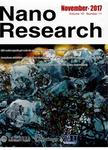Pd/N-doped carbon dots@dendritic mesoporous silica nanospheres:A highly efficient catalyst for the hydrogenation of 4-nitrophenol
作者机构:College of ChemistryZhengzhou University100 Kexue AvenueZhengzhou 450001China Department of ChemistryLaboratory of Advanced MaterialsShanghai Key Laboratory of Molecular Catalysis and Innovative Materialsand State Key Laboratory of Molecular Engineering of PolymersFudan UniversityShanghai 200433China State Key Laboratory of Chemical Resource EngineeringBeijing Advanced Innovation Center for Soft Matter Science and EngineeringBeijing University of Chemical TechnologyBeijing 100029China
出 版 物:《Nano Research》 (纳米研究(英文版))
年 卷 期:2024年第17卷第9期
页 面:7967-7974页
核心收录:
学科分类:081704[工学-应用化学] 07[理学] 0817[工学-化学工程与技术] 0806[工学-冶金工程] 070304[理学-物理化学(含∶化学物理)] 08[工学] 070203[理学-原子与分子物理] 0703[理学-化学] 0714[理学-统计学(可授理学、经济学学位)] 0701[理学-数学] 0702[理学-物理学]
基 金:supported by the National Key R&D Program of China(No.2022YFA1503501) the National Natural Science Foundation of China(Nos.22088101 and U21A20329) Program of Shanghai Academic Research Leader(No.21XD1420800) Shanghai Pilot Program for Basic Research-FuDan University 21TQ1400100(21TQ008) “Shuguang Program”supported by Shanghai Education Development Foundation and Shanghai Municipal Education Commission(No.22SG02)
主 题:palladium nanoparticles nitrogen-doped carbon dots dendritic mesoporous silica catalytic hydrogenation 4-nitrophenol reduction
摘 要:Highly dispersed Pd/N-doped carbon dots(Pd/NCDs)were successfully immobilized in the mesoporous channels of amino-functionalized dendritic mesoporous silica nanospheres(NMS).The synthesized Pd/NCDs@NMS catalyst exhibits outstanding performance in the catalytic reduction of 4-nitrophenol(4-NP),achieving a turnover frequency of 1461.8 mol·molPd^(-1)·h^(-1),with the conversion rate remaining above 80%after 11 *** and density functional theory calculations reveal that the NCDs significantly affect the electronic structure of Pd nanoparticles,leading to changes in the energy barriers for the adsorption of 4-NP at the Pd sites and the conversion of 4-NP reaction intermediates,which is a key factor contributing to the catalytic *** study offers a new strategy for synthesizing carbon-dot-modified metal-based catalysts.



